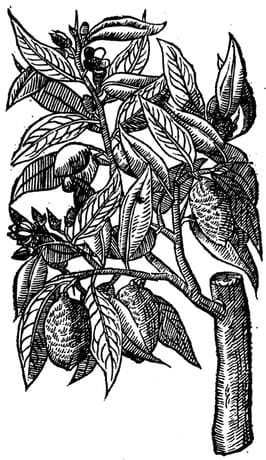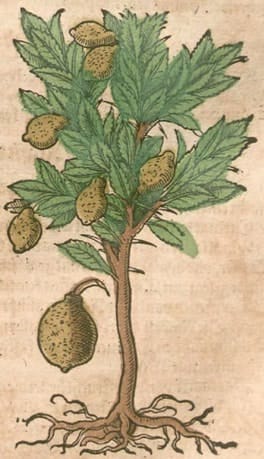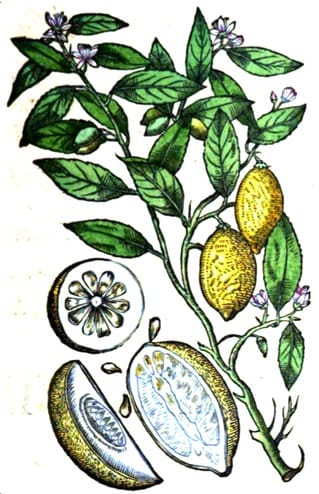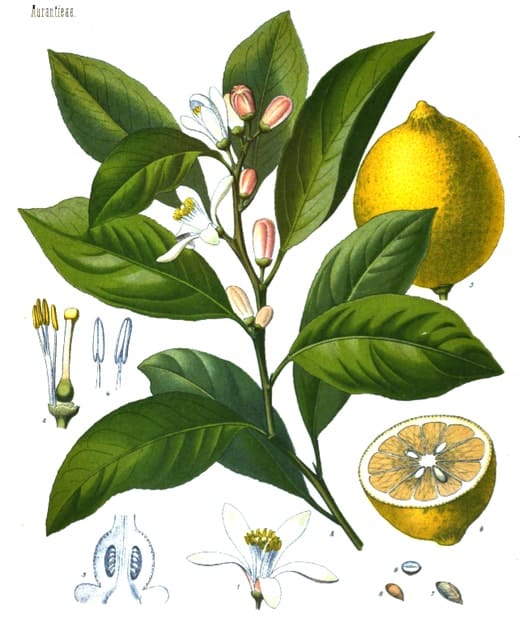Limonum, Lemon
Leemu (Unani)

|

|
|
Parkinson, Theatrum Botanicum, 1640 |
Krauterbuch, Lonitzer, 1578 |
 Kreutterbuch, Matthiolus, 1586
Kreutterbuch, Matthiolus, 1586 Kohler’s Medizinal Pflanzen, 1887
Kohler’s Medizinal Pflanzen, 1887Botanical name:
Citrus limonum (syn. Citrus medica, Malus medica, Malum citrum)
Parts used:
Peel, Fruit
Temperature & Taste:
Peel: Warm, dry. Pungent, Sour, Aromatic; Fruit: Cool, dry. Sour, Sweet.
Classifications:
Fruit: B. Clears Heat
Uses:
PEEL:
Peel is used as Orange and Citron peel; it is not as warm, but is drier
1. Moves the Qi, Relieves Constraint:
-abdominal distention, colic, bloating, cramping
2. Opens Obstructions, Promotes Urine:
-some regarded it as specific for stopped Urine
3. Resists Poison:
-Resists Poison; insect and animal bites
JUICE:
1. Clears Heat, Relieves Thirst:
-juice is good for Fevers and Hot diseases; Dysentery
-Thirst, Night-sweats
-Cough, Cold, Whooping Cough, Asthma; as a gargle for Diphtheria
2. Clears Liver Heat:
-Headache
-Biliousness; Acute Jaundice, Hepatitis
-Hypertension, Arteriosclerosis
-promotes Urine, breaks Stones; acute Arthritis, acute Rheumatism
-settles Nausea and Vomiting; also for obstinate Hiccough
Main Combinations:
1. For soft and fair skin, small Lemons, dry Figs, Elecampane (equal parts), beat them well. Add boiled wheat and boil them all together in 1 part Vinegar and 2 parts Water. Wash the face with it often. (The Secrets of Alexis, 1615)
2. To remove Wrinkles, take an old Capon, feathers and bowels removed and stuff him with small Lemons cut and Fennel seed. Distil and wash the face with this water to remove wrinkles. (The Secrets of Alexis, 1615)
JUICE:
1. Whooping Cough, Bronchitis, simmer Lemon and Flax seed in water, strain and add Honey
2. Gall stones, Biliousness, Liver congestion; take a tablespoon of Olive oil, followed by a tablespoon of Lemon juice
3. Itchiness of the Skin, mix Lemon juice with oil of Rose for topical application
4. Lemon Bath to soothe, refresh and invigorate the skin. Cut and soak 5 lemons in a bowl of hot water and infuse half an hour. Add to the bath water.
5. Kidney disorders: distilled water of Pellitory of the Wall (4 oz.), Oil of Sweet Almond, Syrup of Lemon juice (1 oz. each). Take as a draught. (A Treatise on Foreign Drugs, Geoffroy and Thicknesse, 1749)
Cautions:
Generally Safe.
Main Preparations used:
Syrup of Lemon Juice, Distilled Water
-
Extra Info
-
History
|
‘The name of the Lemon in Sanskrit in Nimbuka; in Hindustani, Limbu, Limn, or Ninbu. It is probably originally a Cashmere word, which was transferred to the Sanskrit in comparatively modern times, not in the antiquity. From these sounds the Arabians formed the word Limun, which has passed into the languages of Europe. The lemon was unknown to the inhabitants of ancient Greece and Rome; but it is mentioned in the Book of Nabathsean Agriculture, which is supposed to date from the 3rd or 4th century of our era. The introduction of the tree to Europe is due to the Arabians, yet at what precise period is somewhat doubtful. Arance and Limone are mentioned by an Arabic poet living in the 11th century, in Sicily, quoted by Falcando. The geographer Edrisi, who resided at the court of Roger II., king of Sicily, in the middle of the 12th century, mentions the lemon (limouna) as a very sour fruit of the size of an apple which was one of the productions of Mansouria on the Mahran or Indus; and he speaks of it in a manner that leads one |
to infer it was not then known in Europe. This is the more probable from the fact that there is no mention either of lemon or orange in a letter written A.D. 1239 concerning the cultivation of the lands of the Emperor Frederick II at Palermo, a locality in which these fruits are now produced in large quantity. On the other hand the lemon is noticed at great length by Ibn Baytar of Malaga, who flourished in the first half of the 13th century, but of its cultivation in Spain at that period there is no actual mention. In 1369 at least citron trees, “arbores citronorum,” were planted in Genoa, and there is evidence that also the lemon-tree was grown on the Riviera di Ponente about the middle of the loth century, since Limones and also Citri are mentioned in the manuscript Livre d’Administration of the city of Savona, under date 1486. Thelemon was cultivated as early as 1494 in the Azores, whence the fruit used to be largely shipped to England; but since the year 1838 the exportation has totally ceased. |
General History of the Citrus
|
‘Orange and Lemons were introduced into Europe from India by the Arabians, and were used by Avicenna and the early Arabian physicians medicinally. According to Dutt (Hindu Materia Mcdica, p. 126,) the different species of Citrus described by Sanskrit writers are as follows :— Jambira, Citrus acida, Roxb. Var. 3 Limpdka, do. do. 1 Nimbuka, do. do. 2 Vijapura, do. do. 7 Madhukarkatika, do. do. 9 Mahalunga, Citrus medica. Karuna, do. do. Var. Nagaranga, Citrus aurantium “The variety of Citrus acida, called Jambira, yields the Lemon juice used in medicine. Limpaka is much used as a sauce by the natives. The fruits are cut vertically into two pieces, and the fresh juice is sprinkled on soup, dal, curry, &c, to which it imparts a pleasant acid taste and agreeable flavour. A pickle of this fruit in its own juice and salt is a popular and effectual medicine for indigestion brought on by excess in eating, or by indigestible articles of diet. The fruits are first rubbed upon a stone, or their rind scraped a little so as to thin it; they are then steeped in juice obtained from other fruits of the sort, and exposed to the sun for a few days with the addition of common salt; when crisp and of a brown colour, they are preserved in jars. This preparation is called Jarak nebu (digestive lemon) in Bengal. The variety called Nimbuka has larger fruit than Limpaka, and is also used as sauce, like the latter, but is inferior to it in flavour and fragrance. Citrus aurantium is called Kamla nebu in Bengali; the variety grown in the plains has an acid taste, and is called Narenga. The Sanskrit term Karuna nimbu is variously translated by different authorities. Wilson in his Sanskrit Dictionary calls it Citrus decumana. In the Hortus Bengalensis it is translated Citrus medica, while Drury and other Madras authorities make it Citrus limonum. The Sabdakaldruma does not give any synonym or vernacular term for it, so that it is difficult to say what form is really meant. In the vernacular the term Karuna is applied to a variety of Citrus medica (in the Makhzan-el-Adwiya it is given as the Hindi for Naranj), Citrus decumana has no Sanskrit name. In the vernacular it is called Batavi nebu, from its having been originally brought from Batavia. Madhukarka-tika is probably the sweet lemon, or possibly the citron. Lemon juice is considered cooling, refrigerant, stomachic and useful in dyspepsia, thirst, fever, &c. Fresh lemon juice is recommended to be taken in the evening, for the relief of dyspepsia with vomiting. It enters into the composition of several carminative medicines, such as the Hingvashtaka, &c. In rheumatic affections, such as pleurodynia, sciatica, lumbago, pain in the hip joints, &c, Sarangadhara recommends the administration of lemon juice with the addition of Yavakshara (impure carbonate of potash) and honey. The root of the varietyof Citrus acida, called Limpaka, is one of the principal ingredients in a preparation of Iron called Yakridari lauha. Mahometan writers divide the genus Citrus into Utrunj, citrons; Naranj, oranges; and Limu, lemons; they describe two varieties of Citron— the large, |
which is broad and obtuse at the base, and the small, both ends of which taper equall; both are yellow and fragrant, but the perfume of the small variety is greatest; the rind of both is bitter; the pulp of the small bitter, of the large sweet. Citron rind is said to be hot and dry, the pulp cold and dry if acid, but cold and moist if sweet; the seeds, leaves, and flowers hot and dry. The juice is described as refrigerent and astringent and is said to be digestive and to check bilious vomiting; the rind is tonic and digestive, and is best administered preserved with honey or sugar. The author of the Makhzan-el-Adwiya states that if the rind of a citron be steeped in a vessel of wine it will convert it into vinegar. He also quotes a Mahometan Hadis (tradition), to the effect that Satan will not enter a house in which citrons are kept. The essential oil is extracted by means of sweet oil from the powdered rind, it is considered hot and dry, and is used as a stimulating liniment. The essential oil of the flowers and leaves is extracted in the same way, and is considered to have the same properties. Hakims pretend to dissolve jewels and pearls in citron juice. The seeds are generally stated to bo alexipharmic. With regard to oranges, the Mahometan writers describe the best kind as large, thin-skinned, and smooth; they say that the rind and flowers are hot and dry, the pulp cold and dry, and recommend the fruit in colds and coughs, when febrile symptoms are present; it is best administered baked with sugar. The juice is valuable in bilious affections, and stops bilious diarrhoea. The orange is the safest of the acid fruits; the peel is useful for checking vomiting, and the prevention of intestinal worms. Orange poultice is recommended in some skin affections, such as psoriasis, &c. Oranges are considered to be alexipharmic and disinfectant; orange water stimulating and refreshing. The essence is extracted by oil from the rind and flowers, and is used as a stimulating liniment. Lemons are stated in the Makhzan-el-Adwiya to be of many kinds; those which are thin-skinned and about the size of a hen’s egg are most esteemed; others are described as ovoid and as large as a goose egg. Of all, the juice is the most valuable part; the peel has the same properties as orange peel, but is weaker. The juice is stated to be cold and dry, or, according to some, cold and moist; to be detergent, useful in bilious head aches, and vomiting caused by excess of bile; to purify the blood in scorbutic states of the system; preserved with sugar or honey lemons are recommended for sore throat, and are considered to act as a detergent; they are administered before purgatives to prepare the body for them, and afterwards to check excessive action. Hakims pretend to dissolve jewels and pearls in the juice. The seeds are said to be alexipharmic, and the leaves to have the same properties as those of the citron. Sweet limes and crosses with the orange and citron, produced by tying the trees together, are considered inferior in medicinal properties. (Vegetable Materia Medica of Western India, Dymock, 1885) |
